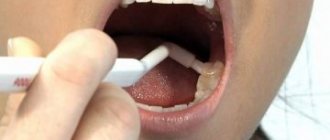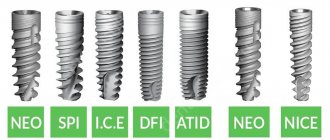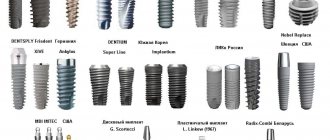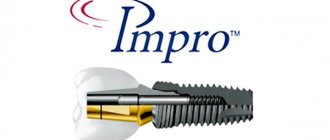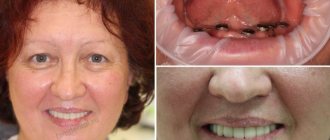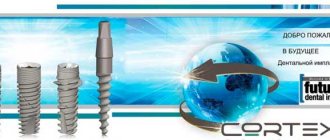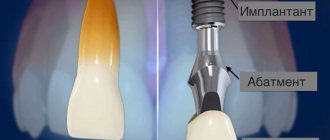In what cases may the bone fail to take root?
The bone may not take root in cases where it becomes infected, including when the patient violated the schedule for taking antibiotics or did not follow the doctor’s orders.
Much attention is paid to food intake: the patient can simply, out of forgetfulness, bite into something hard, and his stitches will come apart, and the material and bone graft will become infected through the open wound.
The above accounts for 90 percent of cases
when the bone may not take root.
Are there any contraindications to bone grafting?
Of course, there are contraindications to bone grafting. These include
:
- various chronic diseases, incl. diabetes mellitus with high sugar levels,
- the period when the patient takes a number of drugs, including chemotherapy,
- in the period after chemotherapy, when the bone cannot be “touched” at all.
Features of hygiene after bone grafting
After bone grafting it is recommended
:
- use of special surgical toothbrushes,
- the use of toothpaste should be limited, and even better, use special toothpastes for post-surgical interventions,
The main thing when carrying out hygiene is NOT TO INJURY
area of bone grafting! You should try to eliminate contact with this area or reduce it to a minimum.
When can you do without bone grafting?
You can always do without bone grafting when you can install an implant of the required diameter and required length into the remaining bone.
And, in fact, you shouldn’t do bone grafting just to assert yourself. Some doctors suffer from this, trying to prove to themselves or someone else how they can do bone grafting.
But, as they say, the best bone grafting is the one we don’t do: if the patient can be rehabilitated without bone grafting, then it’s better to do just that. Since volume can be added with soft tissues, connective tissue can be transplanted - a graft, or drugs can be added to replace the volume of soft tissues - and achieve an excellent result!
Postoperative recovery
After gingivoplasty, the doctor will tell you what needs to be done during the period of soft tissue restoration. Healing lasts from several days to 2-3 weeks. During the postoperative period, patients at our clinic are recommended to:
- take painkillers as prescribed by your doctor;
- reduce physical activity;
- eat warm crushed food;
- exclude spicy foods from the diet;
- rinse the mouth with an antiseptic solution;
- Do not use a toothbrush to clean the suture site.
After the procedure, the swelling lasts up to 5 days, then it begins to subside. If the swelling does not disappear, or complications arise, you should immediately consult a doctor.
To correct a smile using soft tissue, gingivoplasty is the optimal procedure. It is absolutely safe, but there are risks, as with any surgical procedure.
This could be an allergic reaction to the anesthesia (which is extremely rare when using modern anesthetics) or a recurrence of gum recession. In case of relapse, re-treatment is carried out after six months. To avoid this, immediately inform your dentist about any existing diseases.
What implants are used after bone grafting?
Are there “special implants” that are recommended in cases of bone grafting? Both with bone grafting and without bone grafting, it is necessary to use implants only from good, proven manufacturers, those that have a good clinical base. For example – Straumann, Nobel, Ankylos, Xive, Astra Tech.
There are a number of other implant systems that give good results. But at the German Implant Center we use only the best implant systems, only premium ones.
How is implantation performed during bone grafting?
Implantation during bone grafting can be carried out either simultaneously with bone grafting, or delayed - when the implants are installed in the new “grown” bone.
As an experienced implant surgeon, in my practice, in 80-90 percent of cases I perform bone grafting at the same time
with implantation.
I will explain why I perform plastic surgery with implantation at the same time, and what is the advantage of this approach. Bone grafting itself requires a long healing period, from 4 to 9 months. And if we maintain this period and then do implantation, then we have to wait another 4 months. That is, the time frame in this case increases significantly.
And if I do implantation along with bone grafting, then the implant takes root along with the bone. A good implant has an excellent osteogenerating surface, and when fused, an excellent result
.
This reduces the patient’s rehabilitation time. And most importantly, the patient DOES NOT NEED
second surgery. We understand that a large number of surgical interventions do not improve trophism, mucous membranes, or bone tissue.
Everything we do at the German Implant Center, from tooth extraction to implantation, is carried out as atraumatically as possible for the patient.
How many implants are placed during a total restoration?
We specialize very broadly in total implant rehabilitation. In the upper jaw, 6-8 implants are recommended according to our protocol; in the lower jaw, 6 implants are sufficient for total rehabilitation.
Often, implantation occurs simultaneously with the installation of temporary teeth, that is, the patient leaves the clinic “with teeth”, and not on the second or third day, but on the same day when implantation is done:
Preliminary implantation planning is carried out using CBCT, the implants are placed in the required positions.
After this, a surgical template is made, according to which the implants are installed. And based on the same computed tomography (CBCT) and images, a temporary structure is made that will be attached to the implants installed for the patient.
And it turns out the so-called “full case” is when the patient comes, if necessary, if circumstances require it, teeth are removed (or they have already been removed/lost earlier), implants are placed on the patient and an orthopedic structure is fixed - his new teeth.
Indications
The gums may recede when:
- no load;
- periodontal diseases;
- tissue detachment;
- defects caused by injuries.
By tightly adhering to the artificial tooth, soft tissues solve several problems:
- Form an aesthetic gum margin
- Protects the bone tissue around the implant from infection
- Prevents plaque from accumulating in gum pockets
Gum augmentation during implantation can be carried out during the installation of the implant or after its engraftment. It depends on what problem the soft tissue transplantation solves.
On which jaw does tooth bone resorption occur faster?
How quickly does a deficiency of bone and bone tissue occur in the absence of a tooth?
In fact, tooth bone tissue decreases faster in the upper jaw, since the upper jaw is softer and more porous. In the lower jaw, the bone also disappears quite quickly, since the vestibular plate near the teeth is quite thin. Six months after tooth loss, quite severe atrophy of bone tissue occurs, and the atrophy progresses. And therefore, in order to avoid atrophy, it is advisable to do implantation simultaneously immediately after tooth extraction.
This format is the regular, daily work of the specialists of the German Implantology Center. For example, a patient comes with a crack in the root of a tooth - the tooth must be removed. We can go with two options:
Option 1.
We can remove the tooth and 3 months later implant the tooth into the patient.
But during these three months, shrinkage of the bone tissue still occurs, since - I said earlier - the vestibular bone plate is very thin. And in this case, the patient undergoes 2 surgical interventions
: the first is tooth extraction, the second surgical intervention is the installation of a dental implant.
Option 2.
In our practice, we recommend and practice the second option. This is a one-step implantation, when the patient has a tooth removed, an implant is installed, and in order to avoid collapse of the bone tissue in the places where the roots of the tooth used to be, these places are filled with a bone graft. Due to graft filling, we do not have tissue “collapse”; the contour of both the gums and the jaw bone tissue is preserved. Which, in turn, is very difficult to achieve with delayed, delayed implantation.
Who can undergo bone grafting?
Who are potential patients for bone grafting, and what are the age restrictions for it?
This is a bit of a tricky question :). The oldest patient I have performed bone grafting on is a 75-year-old patient, a wonderful, purposeful woman. She had bilateral terminal defects on her lower jaw. She really wanted implantation and refused a removable structure.
I performed bone grafting on this woman at the same time as implantation. And literally 6 months later she was fitted with prosthetics. And everything went great.
In the case of the patient’s age, the main thing is that he has no contraindications. Perhaps there are age restrictions, but they are not so pronounced, because, although trophism deteriorates with age, regenerative abilities decrease, but the main thing is the presence of contraindications. You need to look at the tests, and if the patient is healthy at 75 years old, then why not?
Plastic surgery of soft tissues in implantology
Author: Suheil Boutros and Georgios A. Kotsakis
Introduction
Patient satisfaction with implant treatment largely depends on how natural the implant-supported dentures look. The previous chapter discussed the indications for the use of soft tissue grafts in implantation, from restoration of mucogingival defects to increasing ridge height. Plastic surgery of soft tissues in the area of implants is a group of different techniques that differ in the timing of the operation and the type of soft tissue graft used.
Autogenous epithelialized palatal grafts or free gingival grafts (FGGs) were first proposed for root surface coverage in the 1960s and have since been widely used to increase the level of keratinized gingiva and cover exposed root surfaces. Their use is widespread in practice due to the high predictability of the future result, however, the color match with neighboring tissues is insufficient due to the brighter and more opaque color of the palate tissues compared to the gum, which limits the indications for use in areas where aesthetics are important.
The subepithelial connective tissue graft (SCT) described by Langer and Langer has better color matching and the technique for obtaining the graft is less invasive. Both SDT and SST require a sufficient volume of donor tissue, which may not be easy in cases with large defects and in situations where the patient does not agree to have a second donor site. All these concerns have prompted the use of acellular dermal matrix to treat recessions and soft tissue defects using porcine collagen matrix and tissue engineered cell therapy.
Types of soft tissue grafts
Free Gum Graft (FGG)
Historically, free gingival grafts were the first to launch a wave of development in periodontal plastic surgery, which is aimed at correcting or eliminating defects associated with developmental disorders, or disorders of an anatomical and traumatic nature. Bjorn described a technique for harvesting an autogenous tissue graft containing epithelium and lamina propria to restore the level of keratinized gingiva. Since then, SDT has been used throughout periodontal practice, both in the field of teeth and in the field of implants, with corresponding results. The cascade of tissue regeneration processes after placement of SDT in the recipient zone is carefully described; graft integration proceeds through the following phases: 1) plasma circulation, 2) vascular sprouting, 3) sprouting of connective tissue and vascular ingrowth, 4) maturation of connective tissue.
The main limitation of the use of such grafts is the aesthetic discrepancy between the graft and the adjacent soft tissues. It has been proven that the characteristics of the donor area dictate the phenotype of the transplanted tissue. Thus, an established graft often resembles the mucous membrane of the palate, from where in most cases the tissue is taken; the graft does not fit well with the surrounding tissues in texture and color. In addition, the relief of the palate tissue will remain after transplantation, so it should be removed in order to achieve a more aesthetic integration of the graft. Despite all the aesthetic disadvantages, using this method you can achieve predictable results in increasing the volume of keratinized gums. The use of this method according to indications gives reliable results and is used to increase the area of keratinized gum before augmentation, for example, vertical bone augmentation, also for the purpose of reducing
How to do without bone grafting
Is it possible to do without bone grafting and sinus lift?
Yes, in some cases you can do without bone grafting. But you need to understand that if the patient does not have bone tissue, and we install an implant, the crown will hang over the gum, and something from food will constantly get clogged there. That is, it is aesthetically unsightly, and all the food will be stuffed there, the patient will always have a “pocket of food supplies” from yesterday and the day before yesterday.
Option with a smaller diameter implant
You can place an implant of a smaller diameter, and at the same time we can carry out soft tissue regeneration - replant the mucous membrane (this can be connective tissue from the palate, from the tubercle of the upper jaw). And thus we achieve replenishment of the volume of soft tissues. Due to this, aesthetics are visually improved and hygiene problems are eliminated.
Whenever it is possible to avoid various surgical procedures, but not at the expense of quality, then they should be avoided.
That is, surgery for the sake of surgery - it is not needed
.
Plastic methods
Soft tissue grafting uses several methods. Here are the most common methods of intervention.
- Tunnel. In this case, trauma to the oral cavity is minimized. The surgeon makes small incisions in the mucosa to access the tissue. The wound heals quickly, since the soft tissues of the oral cavity have an increased regeneration rate. The rehabilitation period is minimal.
- Soft tissue grafting uses an autograft. Healthy tissue is collected from the patient himself. This is the most reliable method, since the probability of engraftment tends to 100%.
- For deep correction of the soft tissues of the oral cavity, the method of free plastic surgery with a displaced flap is used.
The dentist chooses the methods of influence based on the characteristics of the situation. All procedures do not require general anesthesia. If you think you need soft tissue plastic surgery, contact our dental clinic in Tula.

